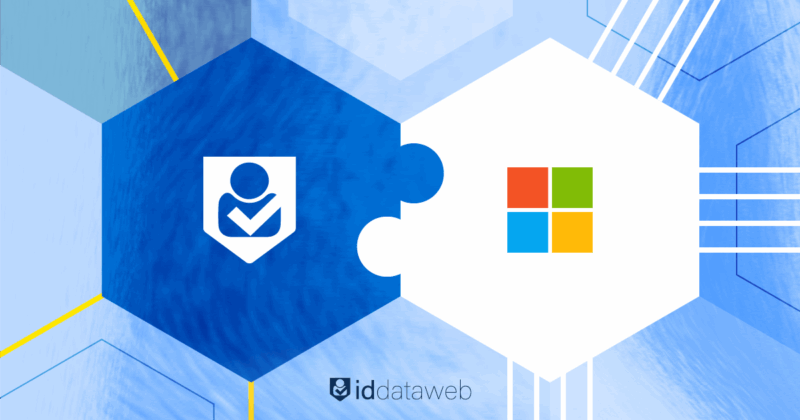Identity-based attacks are surging in scale and sophistication. Account takeover (ATO) losses, in particular, have risen 15% since 2023. Enterprises in finance, healthcare, insurance, and aviation are all seeing fraudsters exploit passwords and static KBA questions. Attackers use billions of breached credentials and improving and deepfake and bot technologies. Meaning, isolated controls that lack dynamic, real-time data are ineffective protections against breaches.
Intelligent orchestration, that layers multiple fraud signals, is one method to adapt authentication flows against threats. Instead of a one-size-fits-all login process, an orchestrated approach evaluates diverse risk signals (device, network, user behavior, identity data, etc.) in real time, then dynamically escalates or relaxes verification based on risk.
Aggregating data from telcos, credit bureaus, fraud consortiums, and government databases, modern identity platforms create a comprehensive risk picture and adjust authentication challenges contextually. The result is a smoother experience for legitimate users and a series of hurdles for fraudsters.
This article outlines five key fraud signals that enterprise security teams should incorporate into their counter-fraud strategy. These signals have proven effective across industry use cases– from credit unions and healthcare networks to insurance portals and airline loyalty programs.
1. Device & network reputation
Device and network reputation signals establish a profile of the user’s device and environment, then flag anomalies that could indicate fraud. This includes device fingerprinting (collecting attributes like OS, browser, hardware IDs), device history (has this device been seen before, or linked to fraud elsewhere?), and network data such as IP address reputation and geo-location.
How it works
In practice, orchestration platforms gather a rich device profile at login. his profile can reveal telltale signs of fraud: mismatched browser settings, emulator or TOR usage, impossible geolocation jumps, or a completely new device for a known user. The platform compares the device and network signals against known patterns – if the login originates from a high-risk environment (like an IP linked to botnets or a spoofed device configuration), the risk engine will respond accordingly. Legitimate users on recognized devices sail through, while suspicious logins face stepped-up verification.
With nearly half of all internet traffic now driven by bots and scripts, device intelligence is a first-line defense. These bots often introduce subtle device anomalies (or appear as brand-new devices with no reputation) that device fingerprinting can catch. Likewise, cybercriminals frequently route logins through VPNs, proxies, or known fraud infrastructure. An orchestration engine that evaluates network reputation will flag logins coming from, say, a data center IP address associated with phishing campaigns
Use cases
Financial services firms rely on device reputational checks to thwart ATO fraud in online banking – for example, flagging a loan application initiated from a device with a fraud consortium blacklisting.
Insurance companies have seen success by profiling agent and customer devices – if a fraudster uses a script to rapidly query policy quotes (a sign of ghost brokering scams), the device signature and unusual velocity will trigger a challenge.
2. Mobile phone & email intelligence
These fraud signals focus on the integrity of a user’s communication channels. It includes verifying that the phone number or email on an account truly belongs to the user (and is currently under their control), as well as checking for red flags like recent SIM swaps, number porting, disposable email domains, or breached email addresses.
Given how often attackers target these channels (think SIM swap scams or phishing), monitoring phone/email signals is essential for a comprehensive fraud defense.
How it works
In an orchestrated flow, phone intelligence often ties into mobile network data and one-time passcode (OTP) challenges. ID Dataweb’s platform, for instance, offers MobileMatch – a service that cross-checks a user’s phone number with telecom carrier records in real-time and sends a one-time link to confirm the device is in their possession.
This not only validates ownership of the phone, but also leverages carrier info to detect if the SIM was recently duplicated or the number was ported to a new device (common tactics in SIM swap attacks). If such a risk is detected, the system can automatically block one-time links to that number and step-up to an alternate verification method.
Similarly, orchestration can assess an email address’s risk profile – for example, flagging if the email is from a known disposable email service or if the address was spotted in a recent data breach. When anomalies arise, the policy engine might require the user to re-confirm their email or perform additional ID proofing.
Use cases
Banks frequently use mobile possession checks to secure online banking – for example, verifying a member’s phone via carrier records during login, and denying high-risk transactions if the number was recently ported (preventing thieves from adding fake payees after a SIM swap).
Airlines are leveraging these signals in their loyalty programs as well – for instance, before allowing large mileage redemptions or account changes, some carriers send an OTP to the member’s registered phone and mandate confirmation, thereby nullifying credentials that alone might have been stolen.
3. User behavior & session anomaly detection
Behavioral and session anomaly signals monitor the when, where, and how of user interactions to detect irregular patterns that could indicate automated abuse or account compromise.
This can include velocity checks (e.g. rapid-fire login attempts or transactions), time-of-day anomalies (user logs in at 3 AM when they never have before), geo-velocity (impossible travel between two login locations in short time), changes in typical behavior within an account, and even behavioral biometrics (keystroke patterns, mouse movements) to differentiate humans from bots.
Essentially, this signal asks: Is the activity we’re seeing normal for this user, or does it smell fishy?
How it works
Modern fraud prevention engines employ a mix of rules and machine learning to analyze each session in real time. Systems crunch data points like the number of failed login attempts, deviations from the user’s usual login schedule, concurrent access from two distant locations, or abnormal navigation patterns once logged in.
If the behavior crosses a risk threshold, the policy engine can initiate step-up authentication (e.g. ask for an MFA or re-prompt identity verification) before allowing further actions.
A concrete example is defense against credential stuffing. A unified risk engine can spot rapid login attempts (velocity anomalies) and repeated failures across multiple accounts, which are telltale signs of a bot testing stolen passwords. The moment such a pattern is recognized, the orchestration might impose a temporary lock or MFA challenge
Similarly, if a user usually only accesses an insurance portal from one city but suddenly their session token appears in a faraway country within an hour, the system can flag the impossible travel and require re-authentication. Behavioral signals are often correlated with device signals too – e.g. an unknown device + unusual hour + large transaction = high risk. By layering these analytics, organizations get a 360° view of not just who the user is, but how legitimate users behave versus attackers.
Use cases
E-commerce companies look at behavioral clues during transactions – if a normally low-spending customer suddenly attempts to purchase 10 high-value items shipping to an unverified address at midnight, the system can delay or vet the order for fraud.
In insurance, behavioral monitoring can catch things like multiple insurance claims filed in rapid succession from the same account or an account that suddenly changes contact information and requests a cash payout (potential indicators of takeover and fraudulent claim filing).
4. Identity verification & PII validation
While the first three signals deal with devices and behavior, this signal is about verifying the actual identity of the user. Identity verification signals (often called “identity proofing” in regulatory terms) involve checking the personal information (PII) provided by a user against authoritative sources to confirm their identity is real and trustworthy.
This can range from basic PII validation (does the name, SSN/SIN, address, date of birth match public or credit records?) to document verification (scanning a driver’s license or passport and ensuring it’s legitimate) to biometric matching (selfie liveness check against the ID photo) and knowledge-based authentication (challenge questions based on the user’s history).
The goal is to catch identity fraud – whether it’s a cybercriminal using stolen details, a synthetic identity (a Frankenstein mix of real and fake data), or someone otherwise impersonating or lying about who they are.
How it works
In an enterprise setting, identity verification can be done at account onboarding, during high-risk actions, or as a step-up whenever other risk signals warrant it. For example,, during new account registration, the orchestration engine might might automatically match the user’s PII (name, Social Security number, etc.) against telecom and credit bureau data to confirm it’s a legitimate identity.
A mismatch (say the SSN has no credit history or the phone number isn’t actually associated with the applicant’s name) would raise a red flag of potential synthetic or stolen identity.
Use cases
Banks leverage identity verification APIs during online account opening to prevent fraudsters from using stolen identities or synthetics. For instance, one credit union might integrate ID Dataweb’s orchestration such that if a new member application’s SSN and name don’t fully match credit bureau records, the applicant is prompted to scan their driver’s license and snap a selfie for biometric comparison. This quickly weeds out fake identities before they enter the system.
5. Threat intelligence & consortium signals
No organization fights fraud alone – many attackers reuse the same stolen identities, devices, or techniques across multiple targets.
Threat intelligence signals use databases and consortiums that aggregate fraud data from many sources. Watchlists of suspicious IPs or devices, lists of compromised or blacklisted identity elements (like emails, phone numbers, account numbers known to be used in fraud), or industry-specific fraud consortium data (for example, a bank consortium sharing profiles of mule accounts, or an insurance bureau flagging identities tied to prior fraudulent claims).
Government and regulatory lists also fall here – such as OFAC sanction lists or law enforcement alerts – which can indicate that a user is high risk.
How it works
In an orchestrated solution, threat intel feeds are integrated as additional signal checks at key decision points. ID Dataweb’s platform, for instance, allows organizations to screen their user directories against third-party fraud data – this can include checking if any existing accounts use identities that appear in a known breach or if any registered device IDs have been reported in a fraud consortium. During authentication, the risk engine will reference these sources in real time.
Similarly, when a user signs up or updates their profile, their details (name, address, etc.) can be checked against public records of fraud (e.g. a database of known synthetic identities or a list of individuals with a history of insurance fraud). If a match or partial match is found, the orchestration can require manual review or additional verification. A great advantage of orchestration is the ability to combine these feeds easily: ID Dataweb’s risk engine can pull data from fraud consortiums, telcos, credit bureaus, and government databases simultaneously as part of each evaluation.
The platform’s policy engine can then automatically block certain high-risk entities – for example, deny any login from a device fingerprint that a consortium partner marked as fraudulent, or oblige identity proofing if an email appears in a dark web breach dataset.
Cybercriminals are notorious for reusing successful tricks and cycling through targets. If one bank shuts down a fraudulent account, the fraudster might try the same identity at a credit union next. Without sharing intelligence, each institution is playing whack-a-mole in isolation. Fraud consortiums and data exchanges break this silo.
Use cases
Healthcare providers are starting to share information about habitual fraud (for instance, patients or providers flagged for insurance fraud). A healthcare network can screen new hire applicants or vendors against healthcare sanction lists to prevent onboarding someone with a known bad record.
Additionally, broad threat feeds (like IP blacklists for botnets or databases of known phishing domains) benefit all industries: a financial services firm can stop login attempts coming from an IP that was identified in a telecom company’s recent bot attack, thanks to a shared threat feed.
Minimize friction.
Maximize security.
Conclusion
Identity fraud will keep evolving – from AI-driven deepfakes to global bot armies – but a strategy built on diverse, orchestrated fraud signals is inherently agile. It learns and adapts with each new threat.
Enterprise security teams that incorporate device and network reputation, phone/email checks, behavioral analytics, robust identity proofing, and threat intel feeds into one cohesive strategy will be far better positioned to stop fraud in its tracks while letting legitimate users move freely.












